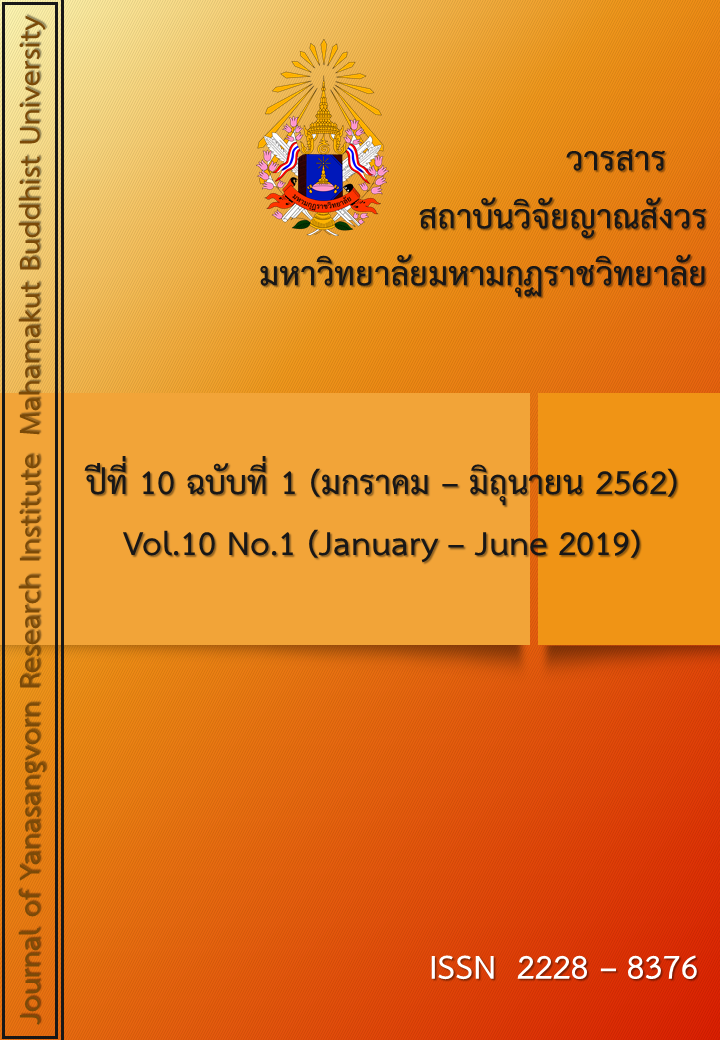THE BUDDHISM PRINCIPLES AND DEPRESSION THERAPY
Main Article Content
Abstract
Depressive disorder or cognitive disorder is a common psychiatric disorder for a long time, that unknown and interested in the general public. but nowadays depression has received attention from people in society all over the world. At present, there were about 322 million or 4.4 percent of depression patients in the world. In Thailand, from the 2018 survey, there were as many as 1.5 million depression patients. It can be seen that the number of depressive patients is large. there are many possible causes of depression disorder. There are both biological factors and social factors. In which many symptoms are found about emotional, physical symptoms, movement due to the mind, Thoughts and Relationship. Which these symptoms affect both themselves for work, families, people around you and to society. the treatment methods for depression can be used in many ways such as; medicine, psychotherapy or brain cell stimulation. In addition to medical treatment, depressive patients or those around them can apply Buddhism principles to prevent or treat depression for examples; The Hindrances; (Nivarrana/Nivorn) means of consciousness to become aware of what emotional state is causing depression or aggravating the symptoms of depression. When he was conscious that will be able to correct the cause of problems, Bases of Sympathy; (Sangahavatthu) for those who are close and create trust among patients. Make the patient feel that he is not alone, dare to speak, consult, which helps reduce the risk of suicide, Sublime States of Mind; (Brahmavihara), for people who are close and make the patients understand better. To reduce negative thoughts about patients and prevent stress that causes depression due to take care of patients, etc. The Buddhism principles, in addition to being used with depression patients, can also be applied to people who are around or close to depression patients, because being with depressed patient needs to rely on understand and tolerance, sometimes you can stressful. Therefore, the application of religious teachings can help both depression patients and those around them.
Article Details
References
พระพรหมคุณาภรณ์ (ป.อ. ปยุตฺโต). (2559). พจนานุกรมพุทธศาสตร์ฉบับประมวลธรรม (พิมพ์ครั้งที่ 34). กรุงเทพฯ: มูลนิธิการศึกษาเพื่อสันติภาพ พระธรรมปิฎก (ป.อ. ปยุตฺโต).
มหามกุฏราชวิทยาลัย. (2557). พระไตรปิฎกและอรรถกถาแปล (พิมพ์ครั้งที่ 8). นครปฐม: โรงพิมพ์ มหามกุฏราชวิทยาลัย.
มาโนช หล่อตระกูล. (2553). การฆ่าตัวตาย : การรักษาและการป้องกัน = Suicide : management and prevention. กรุงเทพฯ: คณะแพทยศาสตร์โรงพยาบาลรามาธิบดี มหาวิทยาลัยมหิดล.
มาโนช หล่อตระกูล และปราโมทย์ สุคนิชย์, บรรณาธิการ. (2558). จิตเวชศาสตร์รามาธิบดี (พิมพ์ครั้งที่ 4). กรุงเทพฯ: ภาควิชาจิตเวชศาสตร์ คณะแพทยศาสตร์ โรงพยาบาลรามาธิบดี มหาวิทยาลัยมหิดล.
อรพรรณ ลือบุญธวัชชัย และพีรพนธ์ ลือบุญธวัชชัย. (2553). การบำบัดรักษาทางจิตสังคมสำหรับโรคซึมเศร้า. กรุงเทพฯ: ธนาเพรส.
World Health Organization. (2017). Depression and Other Common Mental Disorders Global Health Estimates. Switzerland: World Health Organization.
กฤษฎา ศุภวรรธนะกุล. (2562). เจาะปัญหาการฆ่าตัวตายในสังคมไทย สาเหตุการตายผิดธรรมชาติสูงอันดับ 2 รองจากอุบัติเหตุ. ค้นเมื่อ กรกฎาคม 1, 2562 จาก www.hfocus.org/content/2019/05/17140
จิตป่วย” ภัยคุกคามสังคมไทย? จุดชนวนทำผิด... ไม่ต้องรับผิด?. (2561 สิงหาคม 2561). ผู้จัดการออนไลน์ ค้นเมื่อ กรกฎาคม 1, 2562 จาก https://www.dmh.go.th/news-dmh/view.asp?id=28157&fbclid=IwAR2dKsP0yyc7dQz6IthRygs_hTyHMbC_p4g
HunXYUZmAHFY7SNgjIVtTqEI
World Health Organization. (2018). Adolescents: health risks and solutions. Retrieved May 18, 2019, from https://www.who.int/en/news-room/fact-sheets/detail/adolescents-health-risks-and-solutions.
เทียนทิพย์ เดียวกี. (2562). เผยสถิติฆ่าตัวตายเดือนละ 340 ราย จากปัญหาซึมเศร้า. ค้นเมื่อ กรกฎาคม 1, 2562 จาก www.thaihealth.or.th/Content/47606-เผยสถิติฆ่าตัวตาย%20เดือนละ%20340%20ราย%20จากปัญหาโรคซึมเศร้า .html?fbclid=IwAR1y5fj_FdLkNhXvnhSiHRHVkcrQNkWjAf4UJXI_zDYAWF7hWlgbYDvMdkk


